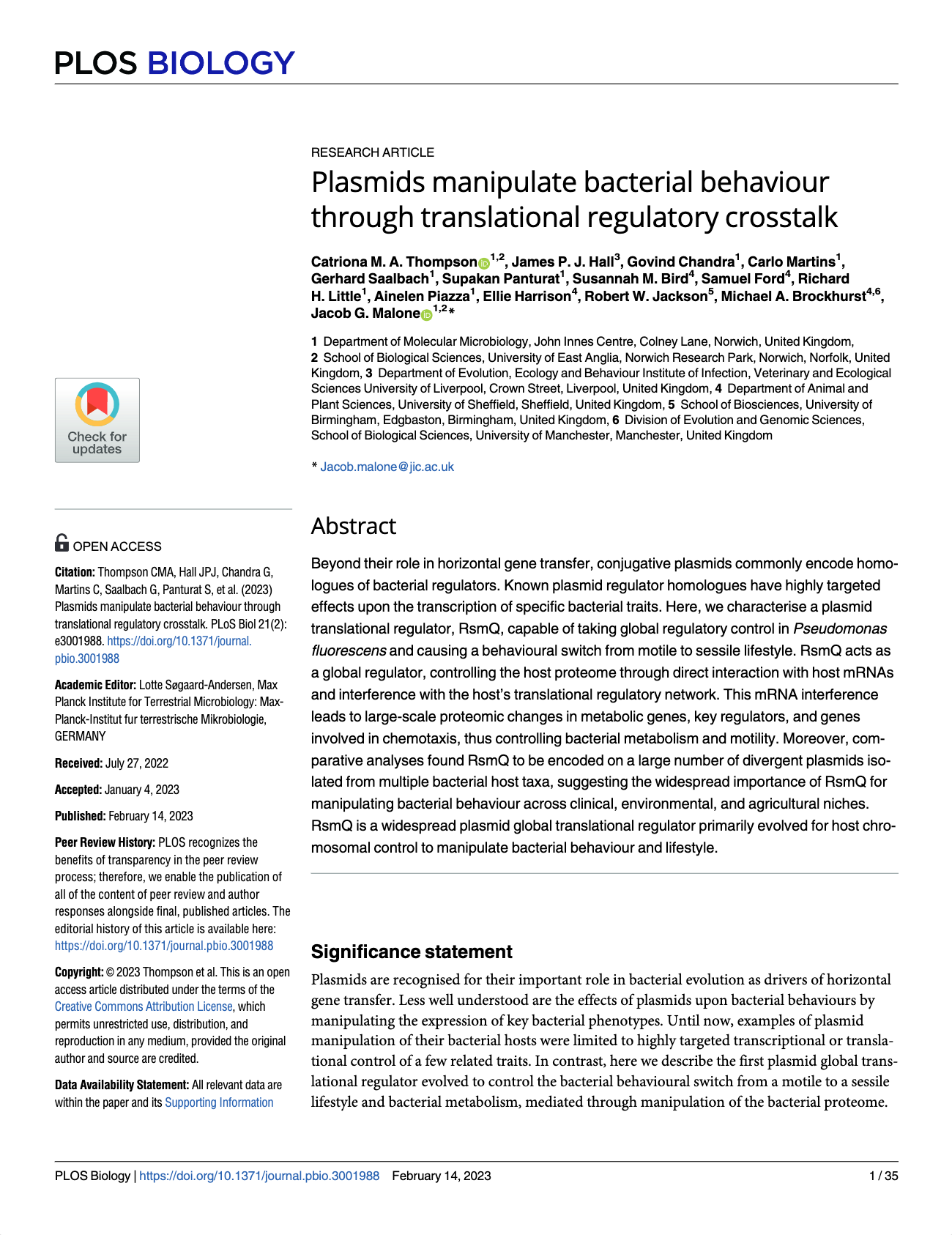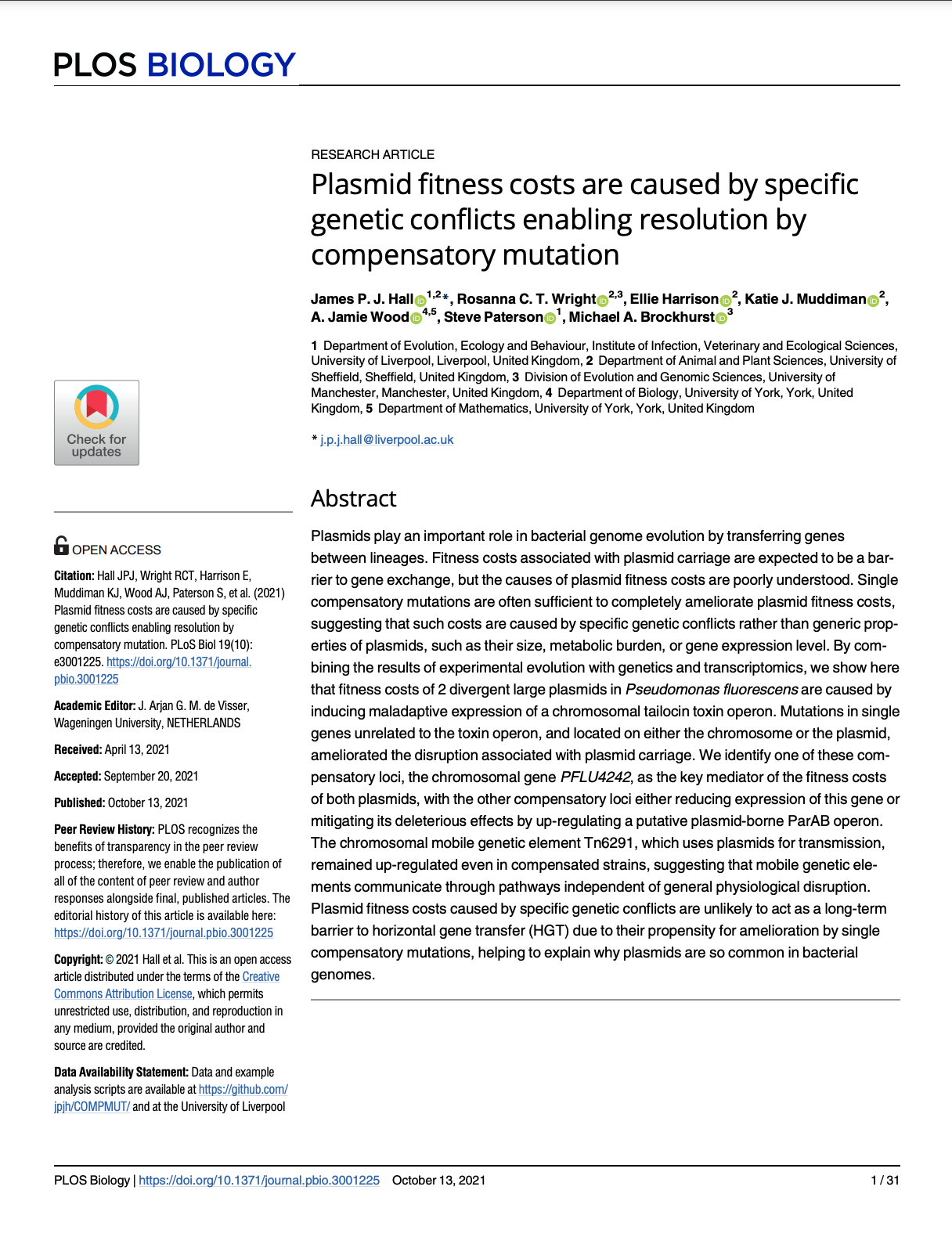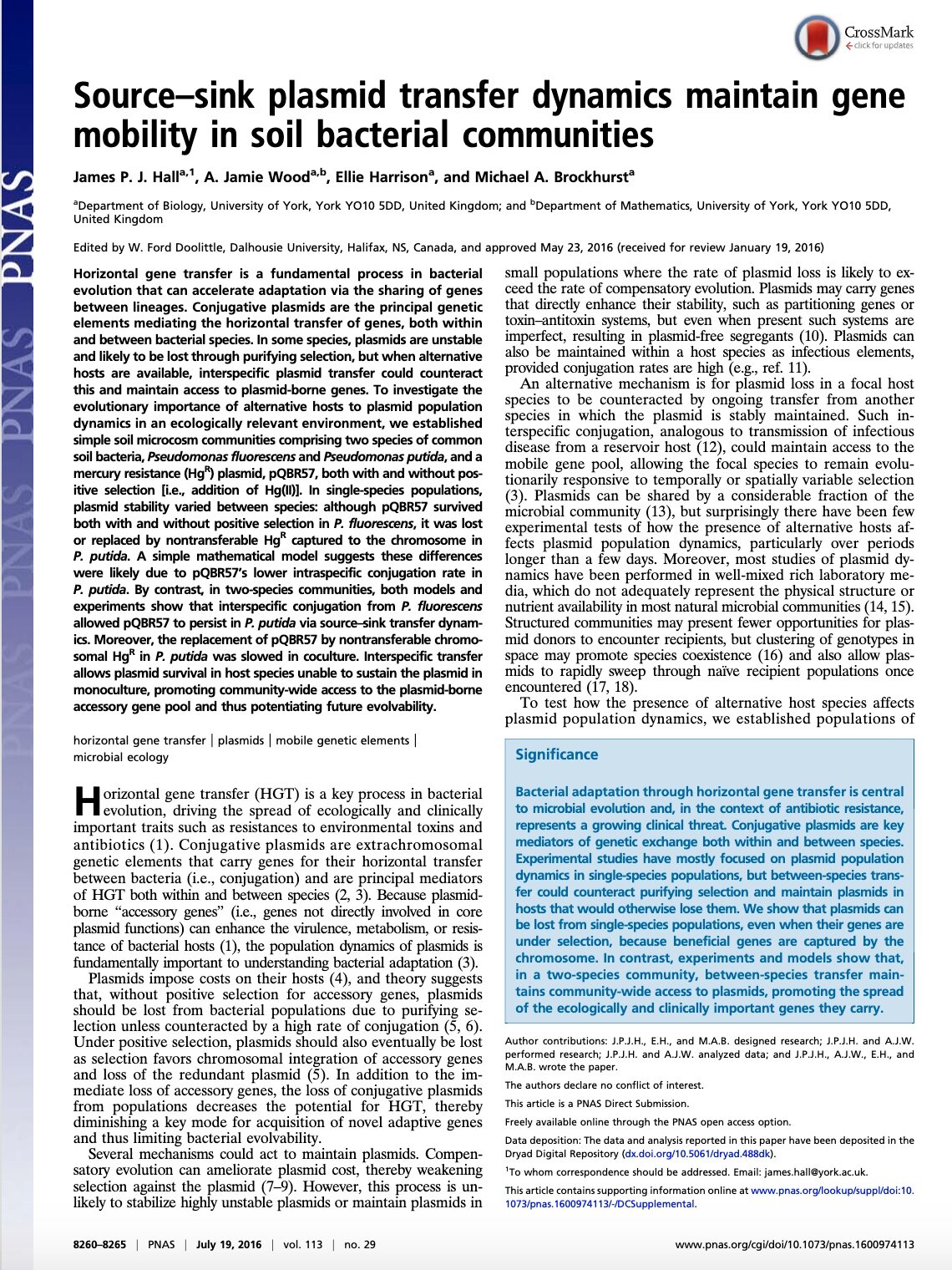
A chromosomal mutation is superior to a plasmid-encoded mutation for plasmid fitness cost compensation
Wright RCT, Wood AJ, Bottery MJ, Muddiman KJ, Paterson S, Harrison E, Brockhurst MA, Hall JPJ. 2024 A chromosomal mutation is superior to a plasmid-encoded mutation for plasmid fitness cost compensation. PLoS Biol. 22, e3002926. (doi:10.1371/journal.pbio.3002926)
Mutations can reduce the fitness costs caused by plasmids. Does it matter whether such compensatory mutations occur on the plasmid, or on the chromosome? Here, we leveraged mathematical models and a new experimental system that allowed us to directly compete different modes of compensatory mutation for the same plasmid. We found that the chromosomal compensatory mutation was more successful, owing to greater efficacy and advantages arising from transmission of costly plasmids to competitors, suggesting that compensated chromosomes could act as ‘hubs’ for plasmid exchange in microbial communities.

Plasmids manipulate bacterial behaviour through translational regulatory crosstalk
Thompson CMA, Hall JPJ, Chandra G, Martins C, Saalbach G, Panturat S, Bird SM, Ford S, Little RH, Piazza A, Harrison E, Jackson RW, Brockhurst MA, Malone JG (2023) PLoS Biology 21, e3001988. (doi:10.1371/journal.pbio.3001988)
Plasmids are known to carry important functional genes like those encoding antibiotic resistance enzymes, but plasmids can also be a lot more subtle. Here we explore a family of plasmid translational regulators that mimic members of a highly conserved chromosomally-encoded regulation cascade, and show that, besides providing useful tools, plasmids can manipulate bacterial behaviour and lifestyle in complex ways.

The Secret Lives of Microbial Mobile Genetic Elements
Editors: Hall JPJ, Harrison E, Baltrus D (2022). Philosophical Transactions of the Royal Society B Theme Issue. Volume 377, Issue 1842, 17 January 2022
Mobile genetic elements (MGEs), such as plasmids, transposons, and bacteriophages can have distinct fitness ‘interests’ and evolutionary trajectories as semi-autonomous entities living in symbiosis with microbes. In this theme issue, we take an ‘MGE-eye view’ of microbiology, reflecting the increasing appreciation of the ubiquity, impact, versatility, and diversity of MGEs. Read our introduction to the issue here.

Plasmid fitness costs are caused by specific genetic conflicts enabling resolution by compensatory mutation.
Hall JPJ, Wright RCT, Harrison E., Muddiman K, Wood AJ, Paterson S, & Brockhurst MA (2021). PLoS Biology. doi:10.1371/journal.pbio.3001225
Plasmids impose fitness costs, but what actually causes these costs is obscure. Here, we show that the disruptions caused by acquiring megaplasmids can be resolved by single mutations, indicating that the principal source of plasmid costs is specific gene-gene conflicts, rather than generic properties such as size. Our findings imply that evolution can readily resolve the costs of plasmid carriage, enabling plasmid maintenance in genomes.

The Impact of Mercury Selection and Conjugative Genetic Elements on Community Structure and Resistance Gene Transfer
Hall JPJ, Harrison E, Pärnänen K, Virta M, Brockhurst MA (2020). Frontiers in Microbiology, 11, 1846. doi: 10.3389/fmicb.2020.01846.
Mobile genetic elements can spread adaptive traits between species. We established species-rich soil microbial communities to understand how selection for mobile genetic elements affects microbial community structure. We show how mercury pollution affects community structure, and, by selecting for acquired mobile genetic elements, enables a focal strain to persist in the face of competitors.

A megaplasmid family driving dissemination of multidrug resistance in Pseudomonas
Cazares A, Moore MP, Hall JPJ, Wright LL, Grimes M, Emond-Rhéault J-G, et al. A megaplasmid family driving dissemination of multidrug resistance in Pseudomonas (2020). Nat Commun; 11: 1370. doi: 10.1038/s41467-020-15081-7
Drug resistance in Pseudomonas aeruginosa has often been associated with chromosomal determinants. Here we reveal a diverse family of resistance megaplasmids present in 1-2% of Pseudomonas Genbank submissions, and show a high stability of these plasmids with a high rate of conjugation and low fitness costs.

Extremely fast amelioration of plasmid fitness costs by multiple functionally diverse pathways
Hall JPJ, Wright RCT, Guymer D, Harrison E, & Brockhurst MA (2019). Microbiology. doi: 10.1099/mic.0.000862.
Plasmids cause fitness costs. These fitness costs can be resolved by compensatory evolution, but it wasn’t clear whether this could occur quickly enough to save plasmids. A fortuitous observation inspired this study, which shows mutations ameliorating a very costly plasmid occurring during the process of colony growth. Compensatory evolution is therefore rapid and potent, and we suggest it may often occur during the process of isolating and selecting individual plasmid-containing clones. Read an interview I did for the ‘Editor’s Choice’ section here.

Source–sink plasmid transfer dynamics maintain gene mobility in soil bacterial communities
Hall JPJ, Wood AJ, Harrison E, Brockhurst MA (2016). Proceedings of the National Academy of Sciences, 113(29), 8260–8265, doi:10.1073/pnas.1600974113
Most experimental studies of plasmid dynamics involve single species in broth culture — far cry from the natural environment of most bacteria. Here, we tested how co-culture affected plasmid dynamics in soil microcosms over 450 bacterial generations, and used mathematical models to unpick the findings. We identified a pattern whereby the presence of a plasmid-favourable species maintains community-wide access to plasmids, implying that such plasmid ‘sources’ play a keystone role in facilitating horizontal gene transfer in bacterial communities.







